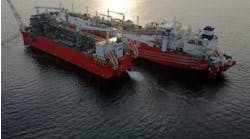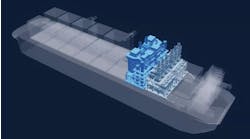Jeremy Beckman - Editor, Europe
Construction work on Allseas’ latest deepwater pipelay vessel,Audacia, is making good progress. Following planned sea trials in the southern North Sea next spring, the vessel should be ready for the 2007 summer season, with three potential assignments in Europe, the Middle East, and the Caribbean.
The DP Class 3Audacia is being converted from the hull of the Geeview, a Panamax bulk carrier built in 2005 at China’s Jiangnan Shipyard. The hull’s mostly pristine condition simplified structural strengthening demands.
“Compared with a newbuild vessel, the price difference is not great,” says Allseas’ President Edward Heerema, “but there is a time advantage with a conversion.
“Economically, it would make sense normally to buy and convert an older ship, but there can also be surprises - sections which are not in a good condition - which may jeopardize the delivery schedule. With this bulk carrier, there were no surprises, but it was also a matter of availability - we paid a premium in order to secure a proper-size ship for our needs.”
Audacia is an in-house Allseas design, its most novel feature being the location of the stinger on the bow. It will be capable of laying pipes in a range of diameters and water depths - up to a maximum of 44-in. outside diameter, plus concrete coating, in waters to 3,000 m deep.
Modification works are being executed at Keppel Verolme in Rotterdam, the same location for the 2005 upgrade ofSolitaire for ultra-deepwater, large diameter pipe installations. With an overall length of 225 m, excluding its stinger, Audacia will be positioned in-between Solitaire and Allseas’ longest-established performer, Lorelay.
The company has committed Eur 275 million to the tanker purchase and conversion program, in expectation that current pipelay activity will be sustained for a few more years. ”We foresee the market staying very busy right through to the end of 2008,” says Edward Heerema. Oil company reaction to the investment has been favorable, he adds. “Clients are always pleased to see additional capacity, because this improves their competitive position.”
Contract prices have also increased since the company announced its plans in June 2005. At some not-too-distant point, however, he expects rates to nose-dive again as the influx of more new vessels prompts a return to overcapacity.
Staffing issues
Allseas’ original target of havingAudacia serviceable this fall proved to be a little ambitious. Final completion looks unlikely now before next April. “The delay has been caused mainly by the tremendous shortage of engineering and construction personnel, and overstretched suppliers,” Heerema explains.
“Everyone in this industry is facing these time problems and constraints on resources. This impacted our internal engineering effort also, but now the situation is under control, and engineering is advanced far enough not to hold up the production schedule.” The final cost will also be “somewhat over budget”, he admits, “but not badly. It’s normal for contractors to underestimate the scope of a conversion job this size.”
TheGeeview arrived in Rotterdam last December, with physical modification work getting under way this February. “Our previous experience working with Keppel Verolme last year on Solitaire was very good,” Heerema says. “We felt it would be fruitful to continue that cooperation, although we did have other options.
“For this project, however, we lacked the time to prepare in advance a complete design and full set of specifications, due to the tight schedule. So we have had to work on this as we have been going along. That made it necessary for us to do joint exercises.” Allseas handled the entire conceptual design internally, with GustoMSC in Schiedam responsible for basic design, and Babcock Design and Technology in the UK contracted for the detailed design.
By early September, the thrusters, main engines and tensioners had been installed, and key elements of the firing line and 240-man accommodation block were in place. By mid-November, much of the build-up work should be finished; thereafter, the focus will switch to cable pulls, and installation of the Imtech-designed electrical and instrumentation systems. Last but not least, the stinger will be put in place.
“We then plan to put the vessel through various trials, firstly in Rotterdam harbor, then farther out into the Southern North Sea. These will include pipelay tests to monitor behavior of the stinger and pipe tensioners, and fine-tuning of the DP3 positioning system - if possible, we would like to do the latter in rough weather.”
The 32 m wide, 19 m deepAudacia will have a draft of 9 m, and a transit speed of 16 knots. Propulsion will be provided by six 5 MW retractable thrusters, with 480 metric tons bollard pull. On-deck lifting/lowering equipment will include a special purpose 150-ton crane and a 550-ton A-frame.
Pipelay equipment will comprise the following:
- One 24-ton pipe transfer crane
- Four pipe storage holds with overhead cranes
- 12 work stations for welding, non-destructive testing and field joint coating
- Three x 175-ton tensioners (total capacity 525 tons)
- Two abandonment and recovery winches with a joint capacity of 550 tons
- One 112-m long stinger, positioned at the bow.
Allseas contracted The Engineering Business in northeast England, to design and manufacture the 38-component pipe-handling system, covering all tasks from pipe load-out to firing line. An integrated control and monitoring system operates each individual element of the system, ensuring accurate welding and safe deployment of pipe sections weighing up to 24 metric tons and up to 12.5 m long.
Line of fire
The idea for the bow-side placement of the stinger was Edward Heerema’s, and Allseas handled all associated conceptual engineering and structural studies in-house. KCI in Schiedam was responsible for the stinger’s detailed engineering.
Heerema felt that by moving the stinger from its traditional aft position, he could reduce distortional effects caused by the conventional need to widen and strengthen the aft ship region. The bowside location would ensure smoother water flow off the stern, with consequent improvements in vessel speed.Audacia should be capable of a transit speed of up to 16 knots, compared to the 12.5 knot limit of Solitaire with its aft-side stinger.
“What this means is that we can do more work in a calendar year -Audacia will be able to sail from Europe to the Gulf of Mexico in two weeks, instead of two and a half weeks doing 12.5 knots. You might argue these are marginal benefits, but every bit of time saved helps.
“There is also a flip side: while in transit, having the stinger on the bow might be a slight disadvantage, causing the vessel to slow down when heading into waves in rough seas. However, we think we have taken care of this issue through strength analysis.”
Uniquely, he claims,Audacia’s tensioners are second-hand equipment - in this case, the original systems installed on Solitaire during the 1996 conversion campaign. These were replaced in 2005 by new systems providing doubled tensioning capacity, as part of Solitaire’s recent upgrade program. The original tensioners were designed and manufactured by Westech - Allseas, however, performed the reconditioning work itself on Audacia’s deck.
“Tensioners are very expensive equipment items,” he explains, “so it was sensible to re-use them. Effectively, we built our new vessel around redundant tensioners,” he jokes. “But these particular items are very flexible, and in good condition: with careful maintenance, including regular change-out of worn parts, you can keep them going for 20 years at least.” While in service onSolitaire, the tensioners handled a total of over 4,700 km of pipes.
Debut program
“Conceptually,” Heerema says, “we have matured our original ideas for this vessel quite well.” The basic dimensions and equipment specifications have not changed markedly since work started in late-2005.
Following sea trials, the first offshore assignment forAudacia should be a straightforward 17-km, 16-in. pipeline installation in the Dutch North Sea, in 30-m water depth. “We knew from the start of our program that the vessel might end up being delayed,” Heerema says, “but the client’s schedule for this project was fairly flexible. No one realistically wants to be the ‘guinea pig’ for a new vessel, but they trusted us, and of course we do not consider this to be a risk.” The next two probable jobs - a 90-km, 26-in. line in 150 m water in the Mediterranean Sea, and a 75-km, 20-in. line in the Atlantic Ocean - also have flexible schedules.
No one can predict with certainty how deep production will go within the next two decades, but further costly upgrades to theAudacia or the Solitaire are not on the agenda. According to Heerema, “the Lorelay could last another 15-20 years, if we maintain it well, while in theory, we could keep Audacia going for 40 years.”
Allseas is, however, keeping its options open for a newbuild, multi-purpose construction vessel -Pieter Schelte - that would combine platform installations and removals with ultra deepwater pipelay work. The original concept for this long-time project was based on a conversion of two tanker hulls, subsequently joined together; the focus at the time was on North Sea decommissioning, but market prospects receded as the oil price rebounded.
At some point, however, some very large, outmoded platforms will have to be removed. “Even then, we couldn’t expect thePieter Schelte to be busy all the time with decommissioning,” Heerema admits, “ but having pipelay capability would give it additional occupancy.”






